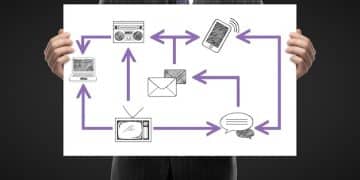Sales funnel improvements that drive results fast

Optimizing your sales funnel involves understanding its stages, avoiding common pitfalls, utilizing automation tools, and measuring success through key performance indicators to enhance customer conversions and satisfaction.
Have you ever thought about how sales funnel improvements could transform your business results? Many entrepreneurs overlook this crucial aspect. In this article, we’ll dive into practical ways to enhance your sales process and see meaningful results.
Understanding the sales funnel stages
Understanding the sales funnel stages is crucial for every business aiming to improve their conversion rates. The sales funnel represents the journey a potential customer takes, from initial awareness to the final purchase. Recognizing each stage helps in tailoring strategies for optimal results.
Aware of the Funnel
The first stage is all about awareness. At this point, potential customers learn about your brand or product. They may find you through ads, social media, or word of mouth. Understanding this phase allows you to create impactful marketing strategies that catch attention and spark interest.
Consideration Stage
Once aware, customers move into the consideration stage. Here, they compare options and seek more information. It’s vital to provide relevant content, such as blog posts or testimonials, to guide them through this phase.
- Use informative blog posts.
- Share case studies from satisfied customers.
- Provide clear product details.
- Engage on social media to answer questions.
These actions help in nurturing leads and keeping them engaged. After consideration, the next step is the decision phase.
Decision Making
During the decision phase, potential customers evaluate their choices before making a purchase. To facilitate this, offering special deals or incentives can be very effective. It encourages users to choose your product over competitors. Ensure you provide clear call-to-actions that propel them towards a buying decision.
Retention and Loyalty
The funnel doesn’t end with a purchase. Retaining customers is equally important. Use follow-up emails, newsletters, or loyalty programs to keep your customers satisfied and returning for more. Happy customers often share their experiences, leading to new potential leads.
This understanding of the sales funnel stages helps businesses create targeted strategies that align with customer behavior. By recognizing where a customer is within the funnel, businesses can tailor their approaches for maximum effectiveness.
Common pitfalls in sales funnels
Identifying the common pitfalls in sales funnels is essential for any business looking to optimize their conversion process. Many companies unknowingly make mistakes that lead to lost sales opportunities. Recognizing these issues can help in creating a more effective sales strategy.
Poor Lead Qualification
One major pitfall is poor lead qualification. If leads aren’t adequately assessed, businesses might waste time and resources on prospects that are unlikely to convert. It’s crucial to establish clear criteria for what makes a quality lead. This ensures that your sales team focuses on the right customers.
Neglecting Follow-Ups
Another common mistake is neglecting follow-ups. After an initial engagement, prospects should be nurtured with timely communications. Failure to follow up can lead to lost interest. Sending a quick email or making a phone call can make a significant difference in keeping potential customers engaged.
- Use automated reminders for follow-ups.
- Segment leads based on interest levels.
- Provide valuable content during the follow-up.
- Utilize multiple communication channels.
Each of these steps can help keep your leads in the funnel and make conversions more likely. Additionally, it’s important to consider the user experience.
Complex Buying Processes
Making the buying process overly complex is another frequent issue. When customers encounter a lengthy or confusing checkout process, they may abandon their carts. Simplifying the steps necessary for a purchase can reduce drop-offs. Streamline forms and provide clear guidance throughout the purchasing process.
Ineffective Use of Analytics
Finally, ineffective use of analytics can hinder funnel optimization. Many businesses gather data but fail to analyze it correctly. Understanding key metrics, such as conversion rates at each stage, is crucial. This data can inform changes needed to improve the sales process.
By avoiding these common pitfalls in sales funnels, businesses can enhance their performance and increase sales. Recognizing these problems will lead to more effective strategies and improved customer engagement. Stay vigilant, assess your processes regularly, and make necessary adjustments to stay ahead of the competition.
Effective strategies for funnel optimization

Implementing effective strategies for funnel optimization can significantly enhance your business’s sales performance. These techniques allow you to create smoother customer journeys, ultimately leading to higher conversion rates. Understanding and applying these strategies ensures that you meet potential customers’ needs at each funnel stage.
Streamline the Customer Journey
To optimize your funnel, start by streamlining the customer journey. Ensure that every interaction with your brand is simple and straightforward. Analyze your funnel for any unnecessary steps that may create confusion. By removing barriers, you can enhance the user experience and keep prospects moving towards a purchase.
Utilize A/B Testing
Another effective strategy is to utilize A/B testing. This method involves comparing two versions of a webpage or email to see which one performs better. By testing different headlines, calls to action, or layouts, you can gather valuable data on what resonates best with your audience. Implement the winning variation to improve your conversion rates.
- Test different headlines to see what grabs attention.
- Compare various layouts to find the most user-friendly option.
- Adjust call-to-action buttons for better click-through rates.
Through A/B testing, you can refine your approach continually, ensuring that your funnel is always optimized for success. Additionally, leveraging automation tools can enhance efficiency.
Automate Follow-Up Processes
Automating follow-up processes is another key strategy. Use marketing automation software to set up automated emails that reach out to leads after specific actions, such as signing up for a newsletter or downloading a resource. Prompt responses keep your brand top of mind and can lead to quicker conversions.
Analyze Data Regularly
Regularly analyzing data is crucial for understanding how well your funnel is performing. Monitor key metrics such as conversion rates, drop-off points, and customer feedback. Use this information to identify which areas need improvement. By being data-driven, you can adapt and optimize your strategies as needed.
Incorporating these effective strategies for funnel optimization can lead to improved performance and higher sales figures. By streamlining the customer journey, utilizing A/B testing, automating follow-ups, and regularly analyzing data, businesses can create a more efficient sales process that drives results.
Measuring the success of your improvements
Measuring the success of your improvements in the sales funnel is vital for understanding what works and what doesn’t. Accurate measurement helps businesses refine their strategies over time and maximize results. By focusing on the right metrics, you can see the true impact of your efforts.
Key Performance Indicators (KPIs)
To effectively measure success, start by defining clear Key Performance Indicators (KPIs). KPIs might include conversion rates, customer acquisition cost, and lead response time. By tracking these metrics, you can gain insight into the efficiency of your funnel.
Conversion Rates
Conversion rates are particularly important. This metric shows how many leads turn into paying customers. By monitoring conversion rates at each stage of the funnel, you can pinpoint areas needing improvement. If you notice a drop-off at a specific stage, it’s a signal to investigate further.
- Track conversion rates across different channels.
- Analyze the performance of specific campaigns.
- Compare current rates with historical data.
This analysis will help you make informed decisions about where to focus your optimization efforts. It’s also crucial to gather feedback from customers.
Customer Feedback
Gathering and analyzing customer feedback can provide valuable insights into their experiences with your sales process. Feedback helps identify pain points and opportunities. Utilize surveys or direct interviews to collect opinions about their journey through the funnel.
Regular Review and Adjustment
Regularly reviewing your metrics is critical. Set a schedule to analyze your KPIs and feedback at least quarterly. Use this data to adjust your strategies as needed. Being proactive allows you to stay ahead of trends and quickly respond to any issues that arise.
By consistently measuring the success of your improvements, you ensure that your sales funnel remains efficient. Understanding your KPIs, analyzing conversion rates, gathering feedback, and conducting regular reviews will empower your business to make data-driven decisions. This ongoing process is essential for continued success and growth within your sales funnel.
Tools to automate your sales funnel
Using the right tools to automate your sales funnel can greatly enhance efficiency and drive conversions. Automation simplifies processes, saves time, and allows your team to focus on higher-value activities. With so many options available, choosing the right tools is essential.
Email Marketing Automation
Email marketing automation tools are pivotal in nurturing leads throughout the funnel. These platforms allow you to send targeted emails at specific intervals, ensuring consistent communication with potential customers. By setting up drip campaigns, you can educate leads and keep your brand top of mind.
Customer Relationship Management (CRM)
A robust Customer Relationship Management (CRM) tool helps manage interactions with customers and prospects. A CRM system can track leads, monitor their journey, and provide insights into their behavior. This data allows you to tailor your approach and improve engagement.
- Centralizes customer information for easy access.
- Automates follow-ups based on customer actions.
- Analyzes sales data for better forecasting.
As leads move through the funnel, the CRM can help ensure they receive the right messages at the right time. Additionally, utilizing marketing automation software can streamline various tasks.
Marketing Automation Platforms
Marketing automation platforms integrate multiple functions, including social media posting, email marketing, and analytics. These tools simplify campaign management and enable you to measure performance across channels. By automating social media posts, you can maintain a consistent online presence without constant manual effort.
Analytics and Reporting Tools
Analytics and reporting tools are vital for understanding how well your funnel is performing. Using these tools, businesses can track vital metrics and adjust strategies accordingly. Continuous monitoring of performance metrics helps identify areas for improvement, ensuring your sales funnel remains effective.
Combining these tools to automate your sales funnel can lead to improved efficiency and increased sales. By leveraging email marketing automation, CRM solutions, comprehensive marketing platforms, and analytics tools, businesses can streamline their processes and optimize their sales efforts for better results.
FAQ – Frequently Asked Questions about Sales Funnel Optimization
What are the key benefits of optimizing my sales funnel?
Optimizing your sales funnel can lead to increased conversion rates, improved customer engagement, and higher overall sales. It enhances the customer journey by making interactions smoother.
How can I identify the common pitfalls in my sales funnel?
You can identify pitfalls by analyzing your conversion rates at each funnel stage, gathering customer feedback, and regularly reviewing your strategies to spot areas for improvement.
What tools can I use to automate my sales funnel?
You can use various tools such as email marketing automation platforms, Customer Relationship Management (CRM) software, and marketing automation platforms to streamline your sales processes.
How do I measure the success of improvements made to my funnel?
To measure success, track Key Performance Indicators (KPIs) such as conversion rates and customer retention rates. Regularly review data and adjust your strategies based on the insights gained.





